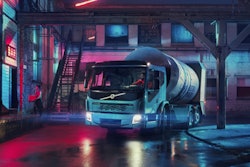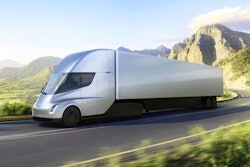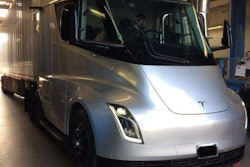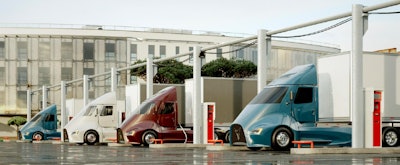 This rendering from Thor shows an example of what a charging station could look like, taking cues from a truck stop’s parking and fuel island.
This rendering from Thor shows an example of what a charging station could look like, taking cues from a truck stop’s parking and fuel island.As the electrified trucking market has sprung to life in the past 18 months, it appears almost certain that these alt-fuel Class 8 trucks will begin sharing the road with diesel-powered rigs as early as late 2019. Industry newcomers Tesla, Nikola and Thor position their electric-powered rigs as viable, clean alternatives to diesel trucks, as well as a way to slash maintenance and fuel costs.
They also have brought fresh designs to the Class 8 tractor, combining aerodynamic features with aggressive styling befitting their role as workhorses.
“We wanted to show people that electric vehicles in the heavy-duty segment can be just as tough and strong as traditional diesel trucks,” says Gio Sordoni, co-founder of startup Thor Trucks, which unveiled in late 2017 a battery-powered Class 8 tractor for the short-haul market.
Even if these trucks perform as well as their makers expect, it’s not clear whether the electrical grid can handle an influx of power-hungry electric trucks, along with other electric vehicles. Also uncertain is whether these truck suppliers and their yet-to-be-built infrastructure can meet the demands of an industry with complex logistics highly dependent on the widespread availability of diesel fueling stations and trucks with long refueling cycles.

TIMELINE: When electric truck makers predict their trucks will hit the road
Infrastructure questions are complicated further because each of today’s three major players in the electrified trucking market targets a different segment of the industry and has its own unique refueling model.
Tesla, already a prominent pioneer in the electric car market, and the 2017-founded California-focused Thor rely on battery power and recharging stations. Thor also plans to offer battery swapping.
Nikola, the first to introduce an electric-focused rig in 2016, requires no batteries. Instead, the Nikola One uses hydrogen as its base fuel, which is converted to electric power by passing quickly over precious-metal membranes.
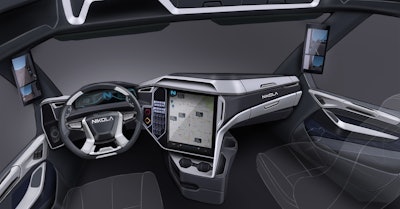 This rendering shows the interior of the Nikola One tractor. A large touchscreen tablet will display information such as battery level, range and mapping, as well as cabin controls. The mapping feature will allow drivers to find Nikola fueling stations and service centers, and a form of freight-matching software also will be included, Nikola says. Screens are mounted on each side to display feeds from cameras.
This rendering shows the interior of the Nikola One tractor. A large touchscreen tablet will display information such as battery level, range and mapping, as well as cabin controls. The mapping feature will allow drivers to find Nikola fueling stations and service centers, and a form of freight-matching software also will be included, Nikola says. Screens are mounted on each side to display feeds from cameras.Tesla’s Semi, unveiled in November, has drawn the most widespread attention, particularly outside the industry. Four months after the truck’s high-profile unveiling, the company hasn’t released its key specifications, such as horsepower and torque ratings, or the weight of its battery units, which could eat into payload capacity. Nor has it said if it’s conducted fleet testing.
Despite these unknowns, fleets have forked over hundreds of thousands of dollars to secure their place in line for Tesla Semis, hoping to be among the first to deploy the all-electric rechargeable Class 8 tractor.
Tesla declined to be interviewed for this story, saying it’s not prepared to provide more detail than was shared at last year’s unveiling.
Private fleets including Anheuser-Busch, Walmart and Pepsi have ordered dozens of Semis at prices ranging from $150,000 to $200,000. For-hire fleets placing orders include J.B. Hunt and Ruan. Jim Cade, Ruan’s vice president of fleet services, says his company’s five-truck order stems from growing concerns over emissions – particularly should other states begin to follow California’s lead of passing strict emissions regulations – and from a desire to get ahead of the competition.
“This is a way to keep our options open and to understand the technology,” Cade says. “We can get it in front of customers to see if there’s a fit. We wanted to get our toe in the water to understand the tech and make sure we’re not left behind in implementing something like that.”
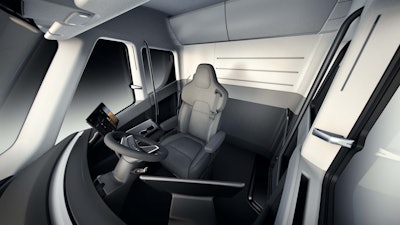 Tesla last November presented a completely reimagined truck interior for its Semi that includes a center-mounted seat, more in the style of a cockpit. On each side of the driver will be large touchscreen displays to house electronic logging applications, navigation, truck information and camera displays.
Tesla last November presented a completely reimagined truck interior for its Semi that includes a center-mounted seat, more in the style of a cockpit. On each side of the driver will be large touchscreen displays to house electronic logging applications, navigation, truck information and camera displays.Tesla has been quiet about its specs even with fleets that have placed orders, says Cade. Ruan’s order is contingent on Tesla producing a working vehicle and further review by the fleet, he says.
“We’re still concerned about the truck’s range,” Cade says. Tesla touted a 500-mile range on a full charge last year, which would fit Ruan’s regional operation of mostly 200- to 300-mile out-and-back runs. “Weight is going to be a big factor for us, and they don’t have answers on that yet. Will it impact our payload?”
His fleet’s Teslas will operate during the day and recharge at night at a station centrally located to those five units’ routes. Tesla expects Semi deliveries to begin late next year, but Cade says that timeline could bleed into 2020.
Nikola’s hydrogen-powered tractor, meanwhile, may be the closest to real-world viability. Backed by hundreds of millions in financing and an ambitious young entrepreneur, the company’s working quickly to develop fueling infrastructure. And unlike its chief competitors in the segment, it’s targeting the long-haul market with a tractor boasting beefy specs: upward of 1,000 hp and 2,000 lb.-ft. of torque with a 1,200-mile range on a tank of hydrogen.
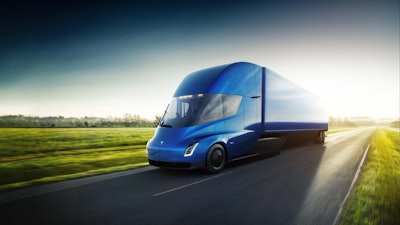 The Tesla Semi was introduced in November 2017.
The Tesla Semi was introduced in November 2017.Trevor Milton, Nikola’s 37-year-old founder, says test units should be delivered to fleets by yearend. The company already has received $2 billion in orders with more than 8,000 reservations, he says.
“Our main goal is to get these trucks in the hands of fleets at the end of the year, and then let them run it and show the world why hydrogen is better,” Milton says. “It has range and weight advantages” over battery-powered trucks, “and it can out-tow diesel. It’s cleaner and more economical.”
The company also has well-entrenched industry partners, including Wabco, Bosch, Meritor and Ryder. The partnership with Ryder alone gives it an 800-location service network “on Day 1,” he says.
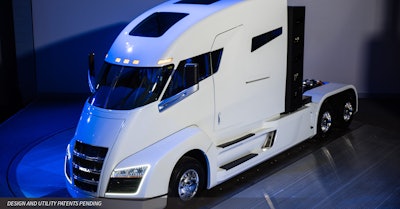 Nikola unveiled its One tractor in December 2016.
Nikola unveiled its One tractor in December 2016.Milton expects two hydrogen fueling stations to be completed by the end of the year, both in the Western half of the United States. Fourteen more stations will be added next year.
“In 2020, we’ll ramp up production with another 50 to 100 stations, and in 2021, we’ll enter full production on trucks and stations.” He anticipates producing 500 trucks in 2021 and 1,500 trucks in 2022. Within 10 years, the company targets producing 35,000 trucks annually.
Thor, founded by Sordoni and business partner Dakota Semler, is conducting fleet testing in California for its ET-One electric tractor. They hope to begin taking orders next year.
The focus now is on short-haul segments such as drayage operations, Sordoni says. The ET-One has a 300-mile range, and its 800-kilowatt-hour battery can be recharged or swapped out for a fresh battery. Instead of public charging and swapping stations, Thor is working with fleets to install such infrastructure at fleet facilities, akin to fleets’ existing onsite diesel pumps.
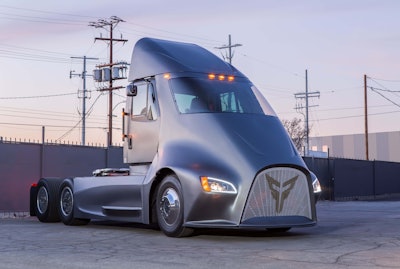 Thor’s ET-One was introduced in December.
Thor’s ET-One was introduced in December.“Eventually, long haul makes sense,” Sordoni says. “Right now, we’re focused on daycab 300-mile-and-under applications.” Thor’s trucks can reach a full charge in 90 minutes, he says, and if the rig needs to be redeployed more quickly, “we would look at battery swapping.”
In the past year, two traditional suppliers also have touted their progress in the fledgling electric market.
Cummins’ Class 7 Aeos is a battery-powered rechargeable tractor and is meant as a prototype to showcase the company’s electrification efforts. “Our approach right now is developing fully electric and hybrid-electric drivetrains and a whole range of components,” says Julie Furber, Cummins’ director of electrification.
To that end, the company recently acquired two battery pack suppliers, Furber says. While the company isn’t commenting further on truck electrification for now, she says the technology doesn’t exist yet for battery-powered long-haul trucks.
Kenworth, meanwhile, has taken the path of Nikola. Last year, the truck maker debuted a hydrogen-electric prototype, using a hydrogen fuel cell to produce electric current. The truck will be deployed this year at Southern California ports.
The 565-hp rig is aimed at the regional market, says Stephen Olsen, Kenworth’s director of product planning. “Our testing shows that this truck performs equally as well as, if not better than, current diesel trucks,” Olsen says.
No other traditional truck makers have introduced an electric rig. Manufacturers such as Daimler and Peterbilt initially are focusing on electrification of short-haul operations, given that segment’s range and more pressing emissions regulations, as it tends to be isolated to urban areas and port applications.
See the other stories below in this series, covering owner-operators’ interest in electric power, whether electric trucks really do offer emissions savings and whether the electric grid can keep up with demand for electric vehicles:

